All of the Kirby Games, Ranked From Worst to Best
In honor of Kirby's 25th anniversary, we ranked them all. Yes, even Kirby Air Ride.
This article first appeared on USgamer, a partner publication of VG247. Some content, such as this article, has been migrated to VG247 for posterity after USgamer's closure - but it has not been edited or further vetted by the VG247 team.
Twenty-five years ago, a pink puffball—well, he was white then—arrived on the Game Boy courtesy of HAL Laboratory. Kirby was a non-descript blob, literally just a placeholder while HAL thought of something better, but the developers eventually warmed to him, and so did gamers.
In the years since, Kirby has served a role similar to that of Wario, allowing Nintendo experiment with different mechanics in a low pressure setting. Some of his best games are the ones that take traditional gameplay tropes and turn them on their head, like the peculiar but lovable Kirby Mass Attack. His malleable nature allows Nintendo to do just about anything with him, even drop him into a pinball game. Through it all, Kirby has remained a fixture in Nintendo's lineup, starring in as many games as Link and Zelda. In honor of his 25th birthday, we ranked them all from worst to best, splitting the "traditional" games from the spinoffs. Few are outright bad, many are just okay, but the ones that really stand out remain a genuine treat even today.

The "Traditional" Kirby Games
16. Kirby Squeak Squad (DS)
Like the earlier Game Boy Advance entry, this is one of the Kirby adventures where HAL Laboratory reached out to some other developers for help. Kirby Squeak Squad was developed by HAL alongside Capcom, Flagship, and even Natsume. The ability to combine copy abilities returns from Kirby 64: The Crystal Shards, albeit in a limited capacity. New features came in the form of Copy Ability storage, allowing Kirby to hide a second ability in his stomach, visually represented on the DS's lower touchscreen. There are also Copy Scrolls, which power up certain Copy Abilities, when used. Despite the new additions, Kirby Squeak Squad felt a bit unoriginal when compared to its predecessor Kirby: Canvas Curse.—Mike
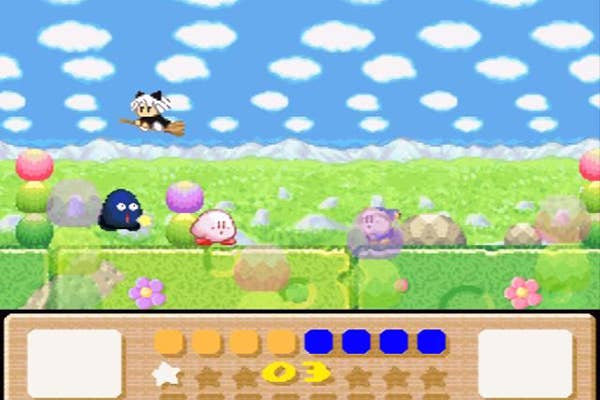
15. Kirby's Dream Land 3 (SNES)
Kirby's Dream Land 3 was Kirby's first wholly original outing on the the Super Nintendo. Kirby's Avalanche and Kirby Super Star actually beat this game out as Kirby's earlier Super Nintendo appearances, but this is HAL Laboratory showing off Kirby in true 16-bit style. You get a full, numbered entry in the franchise featuring more of everything that came before: two-player mode with Gooey from Dream Land 2, twice as many Animal Friends as that title, more Copy abilities. This also stands as one of those weird Nintendo games that are a bit creepy and off-kilter. The real final boss of the game is Zero, who attacks Kirby by cutting itself and bleeding in his direction. It's about as weird as it sounds.—Mike

14. Kirby's Return to Dream Land
I reviewed this one back in the day at GamePro with a couple of my coworkers. It was a pretty straight-forward platformer, more like the original Game Boy game than the NES follow-up, but with New Super Mario Bros-style four-player co-op. It was part of what was at the time a novel revival for Nintendo platformers. It was... okay. I don't have any special memories of it save that I found the levels a bit bland and predictable, much like some of the later Yoshi's Island revivals. Playing with friends was fun; but at the end of the day, it didn't make much of an impact on me.—Kat

13. Kirby 64: The Crystal Shards
This stands as the only Kirby game released on the Nintendo 64 and the only appearance of the pink puffball on the system outside of Super Smash Bros. The game is still nominally a 2D Kirby adventure, but HAL Laboratory wanted to get in on that 3D action, resulting in a half-step 3D viewpoint. The hook here is Kirby can combine his copy abilities into brand-new forms, which was a bit of innovation for the series. Unfortunately, that was the only high point in an otherwise uninspired platformer.—Mike

12. Kirby: Triple Deluxe (3DS)
The "Triple Deluxe" in Kirby: Triple Deluxe refers to the puffball's ability to leap between background layers in this excellent 3DS adventure. Oh sure, Kirby jumps, floats, and inhales his foes as usual, but he can also perform some trickery with the background to conduct some hands-off enemy-thinning. I'll never forget how I was forced to send a bunch of Waddle-Deels plunging to their deaths by triggering a background switch. They weren't menacing me; they were just listening to a lecture from their mentor. And now they're dead. All dead. Triple Deluxe is like strawberry ice cream: Sweet, and so incredibly cold. What a great game, though.—Nadia

11. Kirby's Dream Land
I remember thinking Kirby's Dream Land looked almost as good as an SNES game the first time I played it. The huge, expressive sprites and detailed backgrounds, not to mention the outstanding soundtrack, stood out from the rest of the Game Boy fare of the time. The tradeoff was that it was extremely short--just five levels--and quite a bit easier than other games of the period. But that didn't stop me from beating it over and over again on both normal and hard mode, the latter of which had spikes that were a real pain to navigate. Ultimately, Kirby's Dream Land was more of a prototype than anything, as it lacked Kirby's most distinctive power--the ability to devour enemies and claim their ability. But it established foundation for what was to come, and it's still a fun little platformer today.—Kat

10. Kirby's Dream Land 2
Kirby's Dream Land 2 came out during a bit of a wilderness period for the Game Boy. The by then six-year-old handheld was winding down a bit, and Kirby had already transitioned to home console with his NES debut. But Kirby's Dream Land 2 was still pretty great, improving on the original in pretty much every way while adding in Kirby's trademark power stealing. Its biggest addition were Kirby's animal friends--characters capable of using Kirby's stolen abilities in their own way. It also featured alternate level exits, broadening its scope considerable. Kirby's Dream Land 2 has a tendency to fall between the cracks when discussing the series, but it still has its charms.—Kat
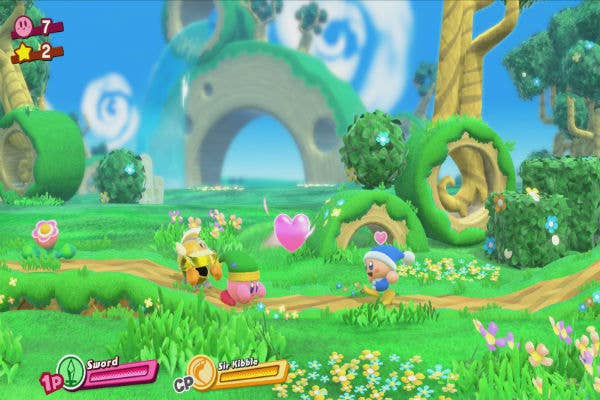
9. Kirby Star Allies (Nintendo Switch)
Kirby Star Allies for the Nintendo Switch isn't the most original Kirby game in town. I prefer Robobot's mech-riding gimmick to Star Allies' friend-making (or strong-arming, depending on how you look at things), but I still had a very good time with Star Allies. It's great to turn Kirby's foes into your own personal army with the flick of a simple heart icon. Your pals fight for you, they die for you, they add their powers to your own, and if all else fails, they go gentle into the good night when you absorb them in a pinch and steal their abilities for yourself. Mix that all in with one heck of a final boss fight, and you've got yourself a Kirby game as rock-solid as Dedede's pecs. —Nadia

8. Kirby: Planet Robobot (3DS)
Kirby is a gastroenteric war machine. Is there any logic in putting this harbinger of oblivion into a mecha-suit? Not really, but gosh, talk about a fun time. In Kirby: Planet Robobot, Kirby uses a mech (colored Pepto-Bismol pink, like his own beautiful self) to annihilate any Waddle-Dees that have the gall to get in his way. Piloting a mech is always a good time, and things are no different in Planet Robobot.
Of course, Kirby can still inhale some quick dinner if he has to hoof it across a level. There are new abilities to copy, including "Doctor." Don't be so quick to scarf down any pills Kirby hands to you, though. He means well, but I don't think he can read the labels on medicine bottles. I wager he thinks "CYANIDE" spells "candy."—Nadia
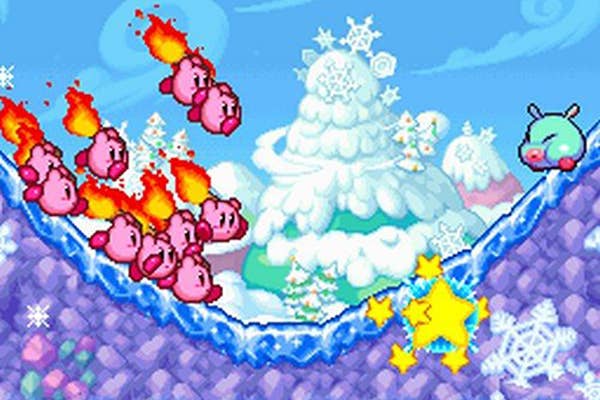
7. Kirby Mass Attack (DS)
You ever see one of those old horror movies where a wailing human being is stripped to the bones by a literal wave of fire-ants? That's Kirby Mass Attack. Sure, it doesn't have the human misery or fire ants, but a swarm of tiny Kirbys is nothing to mock. In this stylus-controlled DS game, you flick up to ten tiny Kirbys onto an enemy, and the little dudes go to work disassembling the threat. I have to say, throwing a whole lot of tiny Kirbys onto my foes is one of the most satisfying action experiences I had on my Nintendo DS. Maybe Mass Attack is less like watching fire-ants at work, and more like watching Japanese honey bees swarm and kill Asian hornets.—Nadia
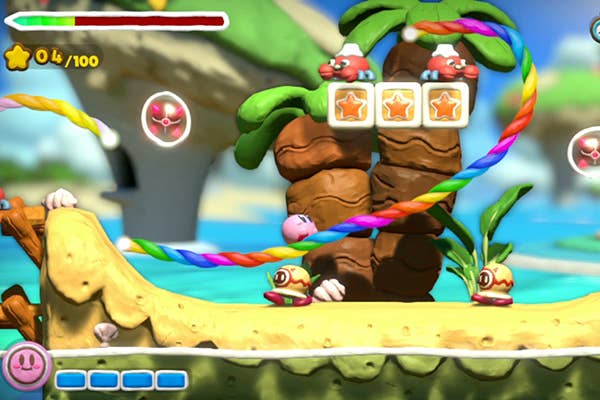
6. Kirby and the Rainbow Curse (Wii U)
Kirby and the Rainbow Curse tries to sell the Wii U's gamepad the way Canvas Curse sold the Nintendo DS's touch-screen function. Rainbow Curse's sales pitch isn't quite as strong as Canvas Curse's, but there's still quite a bit of fun to be had in this oft-overlooked Wii U platformer. For one thing, the visuals are a treat: The Plasticine-based graphics are obviously supposed to be an evolution of Epic Yarn's wooly outlines, and they're a joy to look at. Messing with Plasticine was one of my favorite childhood pastimes, so Rainbow Curse evokes all sorts of fun memories for me.
Gameplay-wise, Rainbow Curse is a touch tricky. You don't directly control Kirby: Instead, you draw ramps and platforms for him to roll across and over. This hands-off approach won't endear every Kirby fan, but several players still walked away after having a good time—myself included.—Nadia

5. Kirby: Canvas Curse
Like many others, Kirby: Canvas Curse sold me on the Nintendo DS. It was built on a simple but brilliant premise: navigating Kirby through stages by drawing a path for him using the stylus. It could be tricky at times given that Kirby, who was stuck in his ball form, was all but helpless, but the rainbow paths drawn by the stylus were incredibly versatile, able to serve as ramps, platforms, and even walls that could block enemies. It had a fun sense of chaotic momentum to it, and it was the first game to really give me a feel for what a touchscreen could do. Soon enough, I would be using my phone's touchscreen to navigate through all sorts of games, which had the effect of making Kirby: Canvas Curse feel a bit less special. But in era when the touchscreen was still relatively new, it felt fresh and inventive.—Kat
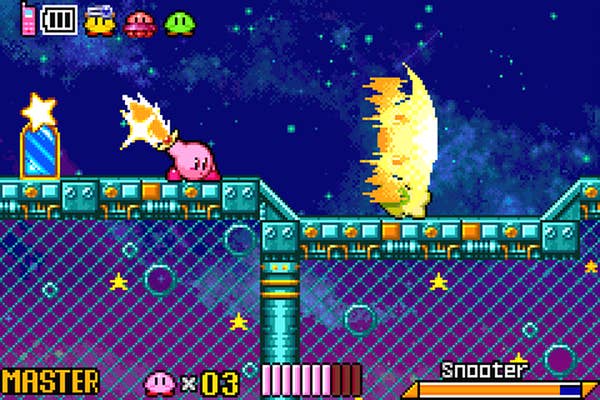
4. Kirby and the Amazing Mirror (GBA)
I think one aspect that always drew me to Kirby as a kid, in contrast to Mario, was how colorful Kirby's world often was. Kirby flew across worlds that had more hues than red and green, and was all the better for it. Kirby and the Amazing Mirror, another Game Boy Advance entry, looks like someone threw all my coloring books as a kid into a blender, and this rainbow puke was the result. Kirby and the Amazing Mirror is a co-op game in-line with The Legend of Zelda: Four Swords, and succeeds where Four Swords failed. Kirby, at the barest principle, is a series built with co-op combat easily implementable. With Zelda, a primarily single-player, story-driven experience, adding more characters into the threshold made for a cluttered and frustrating game. Kirby and the Amazing Mirror isn't though, with all four Kirbys working together perfectly to return to their single self.—Caty

3. Kirby's Epic Yarn (Wii)
There's a tangibility to Kirby's Epic Yarn that's missing from most Kirby games. The big, lovable pink orb is outlined with a single string of yarn. The game's handcraft feel spun a stylistic (and mechanical) spin on the familiar, 2D side-scrolling platforming Kirby lived by. Thanks to yarn, Kirby now twisted himself into many shapes in lieu of donning the costumes of his consumable enemies. Kirby could be a spaceship, a cannon, or even a car. Kirby was fully malleable for the first time of his career; he didn't just impersonate his enemies, he became them. Kirby's Epic Yarn may have spawned an (arguably) better successor co-opting its saccharine image in Yoshi's Woolly World, but Kirby's Epic Yarn singlehandedly revitalized a series that had grown tired and unimaginative. And did it all with a single, perfect pink string of yarn.—Caty
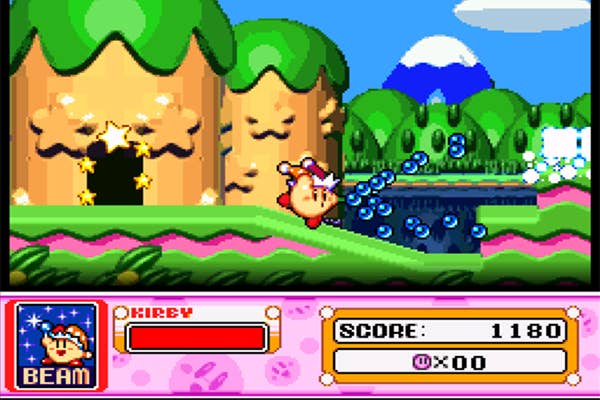
2. Kirby Super Star / Kirby Super Star Ultra (SNES / DS)
The Kirby Super Star games are kind of like sampler platters that offer a taste of what Kirby is capable of. We're not talking about the cheap bits of food they hand out at Costco, though. All the games contained within Kirby Super Star and Super Star Ultra dish out substantial content, and are a lot of fun.
Some of Super Star's games are on the shorter side (like shooting challenges and a boss battle arena), while others are nearly as long as self-contained Kirby adventures (like a jaunt that sees Kirby travel to different planets to end the war between Planet Popstar's Sun and Moon).
Kirby Super Star Ultra is an updated version of Super Star for the Nintendo DS. It contains all the old games on Super Star, plus it adds several more in addition to updated graphics and bonus content. If you're hyper-new to Kirby and you're not sure if his float-and-eat gameplay is something you'd dig, the Super Star games are a great way to get your bearings. Both iterations are great, but the original SNES release is a snap to pick up via the Wii or Wii U Virtual Console.—Nadia
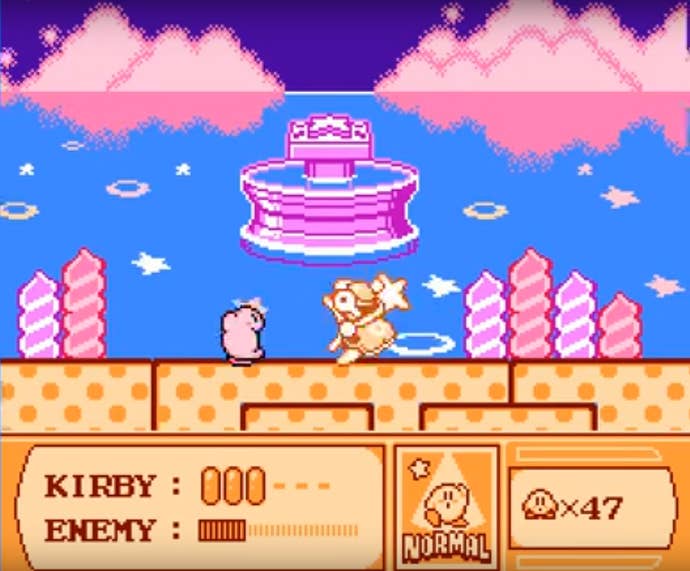
1. Kirby's Adventure / Nightmare in Dreamland (NES/Game Boy Advance)
Kirby's Adventure confused the hell out of me when it first came out. Why was Kirby pink? Wasn't he a ghost of some sort? It completely contradicted the cover of the Game Boy game, where he was white. I wanted answers. Anyway, once I got over that little bit of confusion, I found an exceptional platformer that dramatically grew the Kirby formula and laid the groundwork for everything that was to come. Kirby's Adventure gave the puffball his ability copying power; and like Super Mario World, it had a host of interesting secrets to find. It also had some amazing minigames, including a hilarious quickdraw game that would later be copied by 1-2 Switch some 20 years later. As a latter day NES game, it was one of the most graphically impressive games on the system, with a final battle that nearly matched what was available on the 16-bit platforms of the time. Amazingly, Kirby's Adventure came out just a year before the PlayStation. Damn, the NES really lasted a long time.—Kat
Kirby: Nightmare in Dreamland, an updated remake for the Game Boy Advance of the 1993 classic Kirby Adventure, is Kirby in his truest form. Nightmare in Dreamland is a platformer by Kirby's best standards: a colorful world, eatable enemies, a tree with a face. Nightmare in Dreamland was also the perfect handheld platformer for the Game Boy Advance with its co-op, updated visuals, and different color swaps for the pink blob. I often fondly recall Nightmare in Dreamland as my favorite Kirby game, not for anything in particular, but because it's the first thing that comes to mind when I think of Kirby. And for that, Nightmare in Dreamland is Kirby at his most Kirby, at his best.—Caty
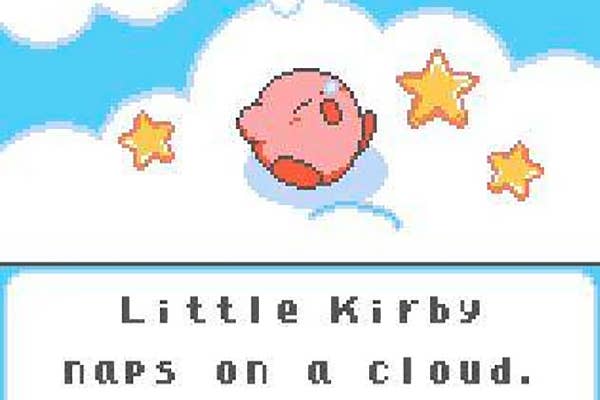
The Spinoffs
7. Kirby Tilt n Tumble (Game Boy Color)
Tilt n' Tumble is kinda awful, isn't it? It was an early manifestation of Nintendo's creative (but not fully formed) motion-controlled ideas. Tilt n' Tumble baited players to fling their Gameboys forwards to tilt Kirby upwards into the air within the game. I wouldn't be surprised if Tilt n' Tumble accidentally resulted in kids with slippery hands giving themselves concussions. The Game Boy and Game Boy Advance bustle with enjoyable Kirby games, and Tilt n' Tumble is 100 percent not one of them.—Caty
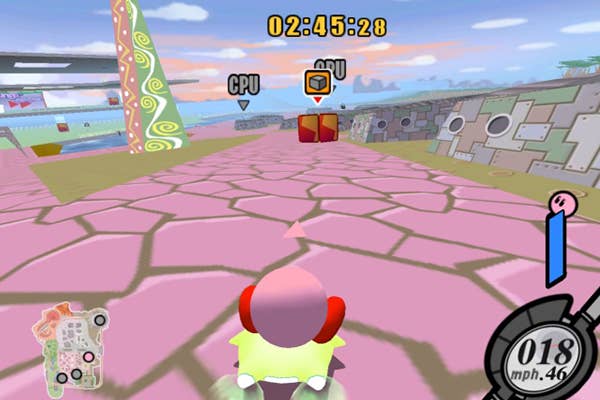
6. Kirby's Air Ride (GameCube)
This game is, well, it's pretty bland. Kirby, a balloon-like critter of questionable origins, has always had the ability to inhale air and float about the sky. Sometimes he'll ride a star. Kirby's Air Ride imagines a Kirby that says to hell with practical travel, what if he only surfed on stars low on the ground instead? The resulting game is one that's part-racing, part collect-a-thon, all boring. At least it has a killer soundtrack.—Caty
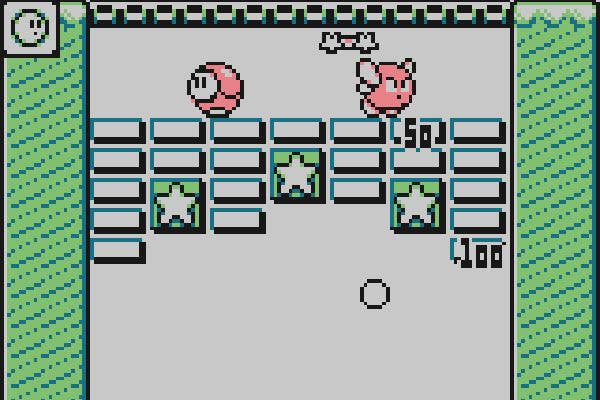
5. Kirby's Block Ball (Game Boy)
You get a feeling that Hal Laboratory was sort of flailing around in-between full-fledged Kirby platformers. This is one of their experiments. Kirby's Block Ball is essentially Breakout with a Kirby skin draped over top of it. The twist is instead of a single paddle at the bottom of the screen, players control multiple paddles bouncing Kirby around the screen breaking blocks. Kirby could also powered up with abilities like stone, flame, and spark, allowing you to break blocks in different ways. It's a kickin' spin on Breakout that still somehow retains the feeling of Kirby.—Mike
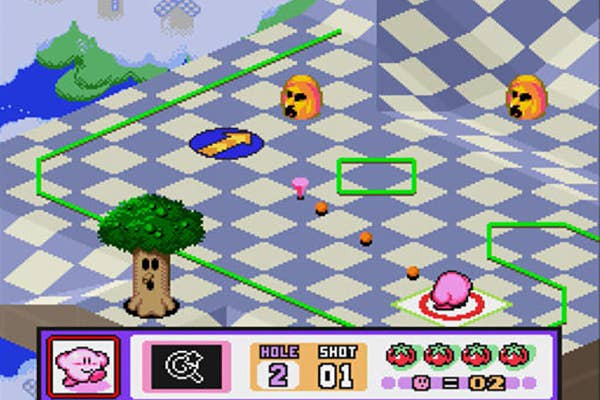
4. Kirby's Dream Course (SNES)
After two side-scrolling adventures, a pinball game, it was time for something different for Kirby. That something was a golf game. Kirby's Dream Course is an isometric golf game, where Kirby is trapped in ball form and you have to whack him around the course. This was actually a repainted version of Special Tee Shot, a Japanese-only golf game. It's a marginally good game, but once you're finished with it, Dream Course sweeps through your brain like a warm breeze.—Mike

3. Kirby's Star Stacker (Game Boy)
Kirby's Star Stacker is essentially just a Tetris (or Dr. Mario) clone, except absurdly cuter. Kirby's friends from Dream Land 2 join the game as special blocks (ripe for the clearing), as one does in a Tetris game. It has four modes in total: Round Clear, VS, Time Attack, and an endless Challenge mode. Kirby's Star Stacker is nothing too special, but it's not abhorrently awful either. It's bite-sized and, well, playable. Which in terms of most Kirby spin-offs, helps it rise to the top.—Caty
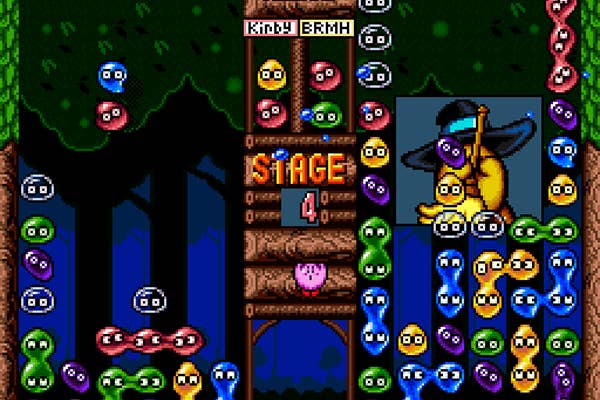
2. Kirby's Avalanche (SNES)
Kirby's Avalanche is a Puyo Puyo game. No, I mean, it's literally a Puyo Puyo game. Avalanche is the North American version of Super Puyo Puyo, which itself was an adaptation of the Puyo Puyo arcade game. The game switches out Compile's own characters for Kirby, King Dedede, Meta Knight and more. Otherwise, it's a Puyo Puyo game, nothing special beyond that to see here.—Mike
1. Kirby's Pinball Land (Game Boy)
Kirby's Pinball Land was one of the first instances I can think of where a popular Nintendo series would be reimagined as a pinball game. Later, Metroid Prime would receive the same treatment, which... okay. Anyway, Kirby is actually a natural fit for the genre, as he can turn into a ball and is naturally bouncy. The result is pretty fun, if a little frustrating-reaching the top of the screen and bouncing around only to fall all the way back down was kind of the worst. That's pinball for you, but it made Kirby's Pinball Land quite difficult. Nevertheless, I have fond memories of it. —Kat









